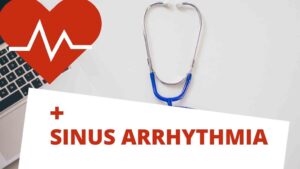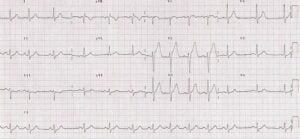Sinus Arrhythmia: Types, Symptoms, Treatment and more
Let’s get started with the basic idea of what is Sinus Arrhythmia.
Sinus Arrhythmia
Sinus arrhythmia is an ordinary variable in the thumping of your heart. Having a sinus arrhythmia may sound startling in light of the fact that the term arrhythmia is likewise used to allude to unpredictable or disrupted heart rhythms, like atrial fibrillation or ventricular fibrillation. These unpredictable or disarranged heart rhythms can be hazardous. Nonetheless, having sinus arrhythmia is an ordinary condition.
Next up is what is respiratory sinus arrhythmia.
Respiratory Sinus Arrhythmia
One kind of sinus arrhythmia, called respiratory sinus arrhythmia, is the point at which the heartbeat changes pace when you breathe in and breathe out. As such, your pulse cycles with your breath. At the point when you take in, your pulse increments. At the point when you breathe out, it falls.
This condition is considerate. It’s a normally happening heartbeat variety, and it doesn’t mean you have a genuine heart condition. Truth be told, this condition is normal in youthful, solid grown-ups and kids. A respiratory sinus arrhythmia can happen in more seasoned people, however, in these cases, it’s normally related to coronary illness or another heart condition.
Let’s get to know what is sinus arrhythmia bradycardia.
Sinus Arrhythmia Bradycardia
In some cases, sinus arrhythmia happens with another condition called sinus bradycardia. Bradycardia, or a sluggish heartbeat, is analyzed when your heart’s regular mood is under 60 pulsates each moment. On the off chance that the low pulse produces extensive stops between beats, you may have sinus bradycardia with sinus arrhythmia. These stops can be common while you rest.
And then comes the question that what is sinus arrhythmia tachycardia.
Sinus Arrhythmia Tachycardia
Another sort of sinus arrhythmia happens when the heart beats excessively quick. This is called sinus tachycardia. It alludes to pulses over 100 beats each moment. Sinus tachycardia is generally an aftereffect of another condition, like pressure, fever, torment, exercise, or prescriptions. In the event that the fast pulse doesn’t resolve rapidly, your primary care physician will treat the fundamental issue.
Sinus Arrhythmia Overview
Sinus Arrhythmia rhythm with a beat-to-beat variety in the P-P span (the time between progressive P waves), creating a sporadic ventricular rate.
Attributes
- Constant P-R stretch – no proof of Mobitz I AV block.
- Variation in the P-P time frame than 120 ms (3 little boxes).
- Normal sinus P waves with a consistent morphology – no proof of untimely atrial compressions.
- The P-P span progressively extends and abbreviates in a repeating style, normally comparing to the periods of the respiratory cycle.
Sinus arrhythmia ought not to be mistaken for conceivably genuine cardiovascular arrhythmias, like atrial fibrillation, supraventricular tachycardia, and heart blocks. Look for sure-fire clinical consideration on the off chance that you, or somebody you are with, have genuine indications.
Now one important question that pops up is what are Sinus Arrhythmia Symptoms.
Sinus Arrhythmia Symptoms
Individuals with sinus arrhythmia don’t encounter any cardiovascular manifestations. Truth be told, you may never encounter side effects of any sort, and the condition may never be analyzed. Sinus arrhythmia is a typical physiological wonder, most normally found in youthful, solid individuals.
- Palpitations
- Dazedness that doesn’t disappear
- Change in mental status, like disarray or confusion
- Motivation builds the pulse by diminishing the vagal tone.
- Trouble breathing, uncommonly quick breathing, or windedness.
- With the beginning of lapse, vagal tone is reestablished, prompting a resulting decline in pulse.
- Chest torment or chest pressure, which may transmit from the chest to the shoulder, arm, or neck.
- The pulse shifts because of reflex changes in vagal tone during the various phases of the respiratory cycle.
- Change in degree of cognizance or readiness, like dormancy, blacking out, lethargy, or uncommon laziness.
Note: “Non-respiratory” sinus arrhythmia which is not connected to the respiratory cycle, is more uncommon, normally happens in older patients, and is bound to be neurotic.
On the off chance that you realize how to identify your heartbeat, you may feel a slight change in your heartbeat rate as you take in and breathe out. In any case, the distinctions might be slight to the point that solitary a machine can recognize the varieties.
Many individuals get curious about Sinus Arrhythmia Causes.
Sinus Arrhythmia Causes
It’s anything but clear what makes individuals foster a sinus arrhythmia. Specialists speculate that an association between the heart, lungs, and vascular framework may assume a part.
Sinus arrhythmia is a typical variety in your pulse. It is brought about by ordinary varieties in a vagal tone. Vagal tone alludes to signals from the vagus nerve. Your vagus nerve runs from your cerebrum to your chest and midsection. Signs from the vagus nerve help control your pulse. Varieties in vagal tone are normal in youngsters and will diminish, however not vanish, with age.
In more established people, a sinus arrhythmia can happen because of coronary illness or another heart condition. Harm to the sinus hub can keep the electrical signs from leaving the hub and delivering a consistent, typical heartbeat. In these cases, sinus arrhythmia is the consequence of harm to the heart, and it’s probably going to appear after the heart condition gets created.
After knowing about Sinus Arrhythmia Causes, people raise the question regarding Sinus Arrhythmia Diagnosis.
Sinus Arrhythmia Diagnosis
Here comes the time for Sinus Arrhythmia in ECG to analyze a sinus arrhythmia. Your primary care physician will lead an electrocardiogram, also known as ECG or EKG to estimates your heart’s electrical signs. Sinus Arrhythmia in ECG can recognize each part of your pulse and help your primary care physician see any expected anomalies.
Sinus Arrhythmia Normal:
In the Ordinary sinus, Sinus Arrhythmia in ECG depicts:
- The P-P span changes broadly from 1.04 seconds with a pulse around 57 bpm and goes down to 0.60 seconds with a pulse around100 bpm which has an inconstancy of over 400ms.
- P waves upstanding in drives I and II along with a consistent morphology yet with an appearance reminiscent of left atrial extension.
- P-R stretch is consistent and no proof of AV block can be found.
Note: For unpredictable sinus arrhythmia rhythms, the ventricular rate is best assessed by increasing the absolute number of edifices in the beat strip by 6. This gives a general pace of 12 x 6 = 72 bpm
Remember that for most individuals, sinus arrhythmia is neither perilous nor tricky. Regardless of whether your PCP speculates you have this sporadic heartbeat, he may not ask you to get the test to check for it. That is on the grounds that Sinus Arrhythmia in ECG can be exorbitant, and a sinus arrhythmia is viewed as a benevolent condition. Your physician may arrange a Sinus Arrhythmia in ECG in particular on the off chance that they speculate another condition or you’re encountering different side effects.
Differential Diagnosis for Sinus Arrhythmia in ECG
There are a few different substances that cause sinus arrhythmia with an unpredictable ventricular rate:
- Type I Sinoatrial Exit Block
- Successive untimely atrial compressions
- Second-degree AV block, Wenckebach phenomenon or Mobitz I
If you have gained knowledge about Sinus Arrhythmia Diagnosis then you must be curious about Sinus Arrhythmia Treatment
Read More: Celine Dion Weight Loss Diet
Sinus Arrhythmia Treatment
You probably won’t require treatment for sinus arrhythmia. Since it’s anything but a typical event and doesn’t prompt some other issues, treatment isn’t required for the vast majority. A sinus arrhythmia may, at last, get imperceptible as youngsters and youthful grown-ups become more seasoned.
And since a respiratory sinus arrhythmia is an ordinary variety in pulse too, so no treatment is required. But on the off chance that you are encountering different side effects, like heart palpitations or skipped pulses, contact your medical services supplier for appropriate assessment.
In the event that you foster a sinus arrhythmia in view of another heart condition, like coronary illness, your primary care physician will probably treat the first condition. Treating the condition may help stop the arrhythmia.
Sinus Arrhythmia Complications
Sinus arrhythmias infrequently cause complexities. Truth be told, the condition is probably going to go unseen since it so once in a while causes indications or issues.
What’s more, as you may have read it already Sinus arrhythmia is an ordinary variety in pulse and doesn’t prompt inconveniences or issues.
In the event that sinus arrhythmia happens with Sinus arrhythmia bradycardia or Sinus arrhythmia tachycardia, you may encounter a few complexities from the mix. For moderate pulses, you may encounter wooziness, windedness, and blacking out. Heart palpitations, dizziness, and chest agonies can happen with unpredictable quick pulses.
Sinus Arrhythmia Conclusion
Most of the individuals with sinus arrhythmia will live typical, sound lives. Some may never at any point realize they have this condition. Recognition and finding may occur unintentionally, and treatment is once in a while vital.
For more seasoned individuals with the condition, it’s significant you work with your PCP to distinguish the hidden reason and treatment that can help. The actual arrhythmia isn’t unsafe, yet a basic condition like coronary illness can not be taken lightly.
We have covered all the topics related to sinus arrhythmia, be it respiratory sinus arrhythmia or sinus arrhythmia in ECG or sinus arrhythmia symptoms or sinus arrhythmia treatment or sinus arrhythmia causes or sinus arrhythmia bradycardia. To keep getting more knowledge about health and fitness keep following us.





